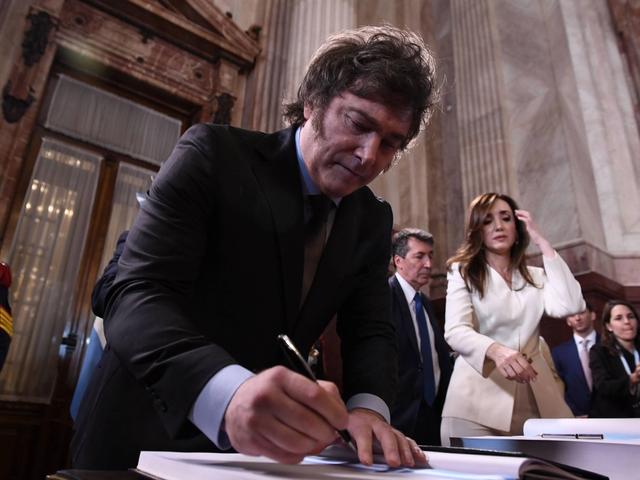Naomi Klein’s 2007 book The Shock Doctrine opens with an evocative quotation from César Aira’s novella Cumpleaños: “Any change is a change in the topic.” Klein perfectly understood both the cyclical nature of the Global South’s enforced crises and the tactical theatrics employed to conceal them. Aira knew all about it as well: this kind of stark, analytical statement underlies the patina of “absurdism” with which his literary output is associated. What they both were pointing out was that Argentines’ lives are governed by a particular type of realism that has to do with the unmanageable and the uncertain; a realism whose mainstay is disorganisation.
Since President Javier Milei took office on 10 December 2023, the changes in topic have accelerated at an inhuman pace, becoming more and more labyrinthine. Public discussion in Argentina has turned to assessing the possibility of a terrorist attack taking place because of the extreme personalisation of foreign policies carried out by Milei, something that was previously unthinkable.
Not unlike the shape-shifting parasite from John Carpenter's film The Thing, Argentina’s inclination to tremor and transience is becoming cruelly enhanced and more warped with each passing day. The topic shifts from the privatisation of all public companies to the hushed death of Alejandro Rubio, the last Peronist poet; from anti-protest federal laws to the drastic collapse of real wages; from the president's compulsive reposting habits on X (formerly Twitter) to the interruption of a state-backed programme that offered free oncological medication.
Millions of people are slowly being pushed to their limits, both in practical and economic terms. Civil rights are being snuffed out while austerity measures hit hard as a shockwave to the collective brain.
As with other workers, artists are also affected by these brutal cuts. The general backdrop is one of deep recession and impoverishment of material conditions, including the halting of most infrastructure projects, scientific research, welfare benefits and community kitchens. But as Argentine art is reliant neither on a robust and flourishing market, nor on substantive state support, but rather on its own brand of feeble private-public partnerships that are barely enough to keep things running, one is inclined to assume that artists are not suffering any more or any less than before.
However, if anything, artists are suffering more because they are users of an urban transportation system that will be subjected to monthly fare increases; because they are young mothers who do not know if their children will start classes; because they must take care of their retired relatives whose pensions have suddenly shrivelled in value; or because they are tenants who cannot afford the rent on their tiny apartments (let alone their studios). The same uncertainty plagues workers at every level of the economy.
When we think of Argentine cultural industries, contemporary art plays the part of a bizarre, secluded planetoid, with limited effect on the estimated 2.4% contribution that culture makes to the country’s gross domestic product. But as even beloved singers and stars of popular daytime television dramas are scrutinised by armies of trolls and pundits because their business has been subsidised by the state, what is left for contemporary artists? Their work has long derived symbolic power and political value precisely from the widely held perception that art need not be a productive form of labour.
Argentine artists are not yet willing to abandon the modern dictum that maintains that they should not be accountable to anyone, which renders them both infallible in how they interpret the world and politically privileged. Can artists be mere workers? Or must they defend their purported exceptionality amid a situation where non-artists are quickly gaining the technical resources to be able to represent themselves? Is contemporary art actually a trench in the cultural battlefield—as it likes to think of itself—or has it become the benign decoration in the war bunker of those who design and execute harmful policies?
If the last edition of the Documenta exhibition demonstrated that contemporary art in an institutional setting cannot engage in serious political production any more, perhaps the time has come to ask if the crisis in contemporary art—whether in Argentina or anywhere else—is that it cannot respond to external factors at all.
- Alejo Ponce de León is a critic and curator. In 2022 he curated Argentina’s presentation at the Venice Biennale, a solo project by Mónica Heller



